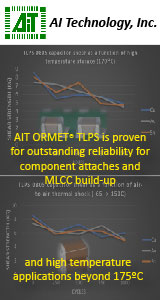|

|
|
| Ask the Experts | |||||||
|
|||||||
|
July 18, 2025 - Updated January 22, 2014 - Originally Posted Solder Mask GhostingSome here are convinced that we have solder mask ghosting on PCBs because our global suppliers are not curing the mask sufficiently. The problem is that our PCB's come from many major suppliers in Taiwan and ASIA, over several different suppliers and board types. I do not buy the notion the entire world chooses to not cure the mask. Any suggestions on how to get more data on the ghosting issue where multiple suppliers are involved? D.M. |
|||||||
| Expert Panel Responses | |||||||
|
I know it's hard to believe but a very real problem that has been occurring for many years, we have even developed a test solution for our Engineers to easily identify/test for Under cured Solder Resist on customers site, as this problem is rife, not just PCB's from the Far East although as many boards come from that direction, so the problem seems to be worse. We even tested one identical single PCB manufactured by five different PCB Manufacturers with alarming differences. This issue obviously causes numerous Wave Soldering, Reflow Soldering and Test issues such as no faults found. Reliability can also be seriously affected due to this issue.
Technical Sales Manager BLT Circuit Services Ltd Greg York has over thirty two years of service in Electronics industry. York has installed over 600 Lead Free Lines in Europe with Solder and flux systems as well as Technical Support on SMT lines and trouble shooting.
Best practice is to thermally cure with a UV bump. You can quickly assess degree of solder mask cure through FTIR or TGA. Insufficient cure can be a big issue and can result in immediate defects (some suggestion that it can influence black pad) and walking wounded. I'm not sure why you would think that the world does not cure solder mask. Note, you could also be having incompatibility between your flux and your solder mask. Have you done an IPC-SM-840 qual with your flux chemistry?
CEO & Managing Partner DfR Solutions Dr. Hillman's specialties include best practices in Design for Reliability, strategies for transitioning to Pb-free, supplier qualification, passive component technology and printed board failure mechanisms.
Like you, I am skeptical that you've got the same problem across multiple suppliers and PWB types. Seems much more likely that there is a common cause elsewhere. One thing that may shed some light is to look at when the problem first appeared, and try to correlate it to process change by detailed investigation on the factory floor. Another avenue is to do some analytical work. Is there any detectable residue present? Is the mask surface eroded, exposing filler? Does baking aboard prior to soldering eliminate the issue? By determining what is the physical cause of the observed ghosting, you are one step close to root cause(s). If a pre-bake (determine time and temperature by talking with the PWB fabricators and mask manufacturers) does not eliminate the issue, you can rule out cure problems.
Process Engineer Astronautics Fritz's career in electronics manufacturing has included diverse engineering roles including PWB fabrication, thick film print & fire, SMT and wave/selective solder process engineering, and electronics materials development and marketing. Fritz's educational background is in mechanical engineering with an emphasis on materials science. Design of Experiments (DoE) techniques have been an area of independent study. Fritz has published over a dozen papers at various industry conferences.
In a previous life, I worked in the commercial sector of the industry, and have a lot of experience with this issue, especially from many years of dealing with Asian PWB fabricators. There does seem to be more of an issue with ghosting,and with soldermask issues in general. So I turned to them for advice on how to solve this problem figuring they would know. One well-known Asian fabricator told me that they use this device to help prevent this issue. While I have not tried it, it certainly does look like a high-tech solution to the problem. https://www.7thsensepsychics.com/stories/ghost-repellent-machine-home/
Advanced Engineer/Scientist General Dynamics Richard D. Stadem is an advanced engineer/scientist for General Dynamics and is also a consulting engineer for other companies. He has 38 years of engineering experience having worked for Honeywell, ADC, Pemstar (now Benchmark), Analog Technologies, and General Dynamics.
Reader Comment
I recently went thru this issue! I have multiple fab suppliers but found only one giving me the issue mentioned above. The fab manufacturer was using a shorter processing time during the mask curing cycle to reduce cost and expedite delivery.
Mark Maheux Sr., Honeywell
We discussed their process being used against the masking manufacturers recommendations. They agreed to adjusted the process by upping the time and temperature of the cure cycle to match the mask specification. We received sample boards and ran it thru our processes. The issue was resolved. |
|||||||
| Submit A Comment | |||||||
|
Comments are reviewed prior to posting. You must include your full name to have your comments posted. We will not post your email address. |
|
Free Newsletter Subscription
Circuitnet is built for professionals who bear the responsibility of looking ahead, imagining the future, and preparing for it. Insert Your Email Address |
|

|




